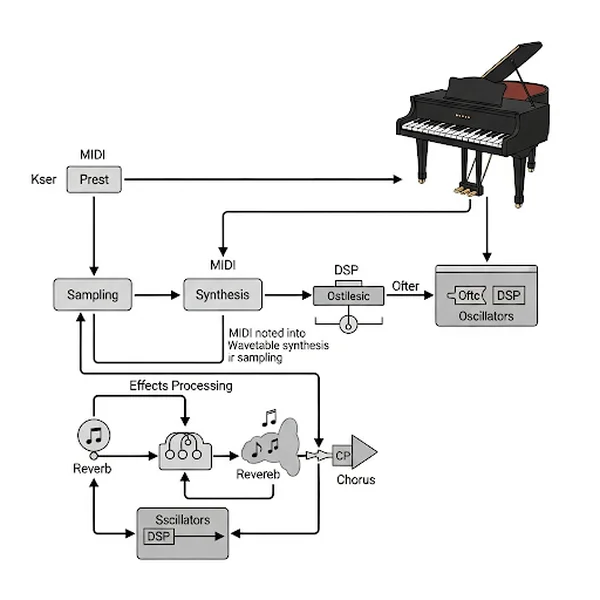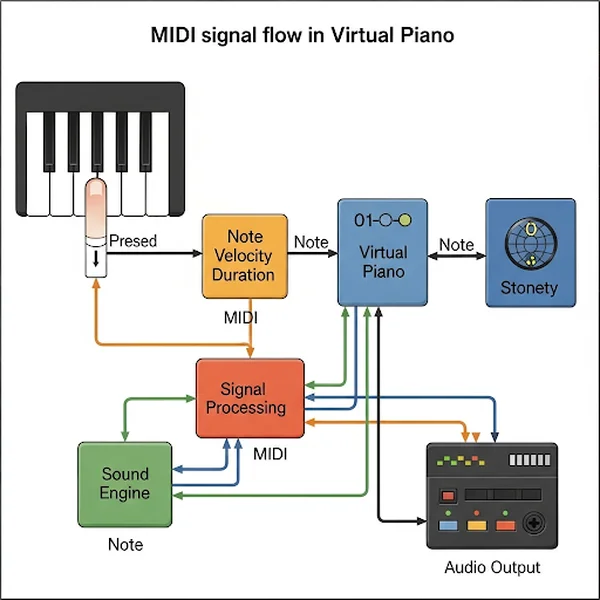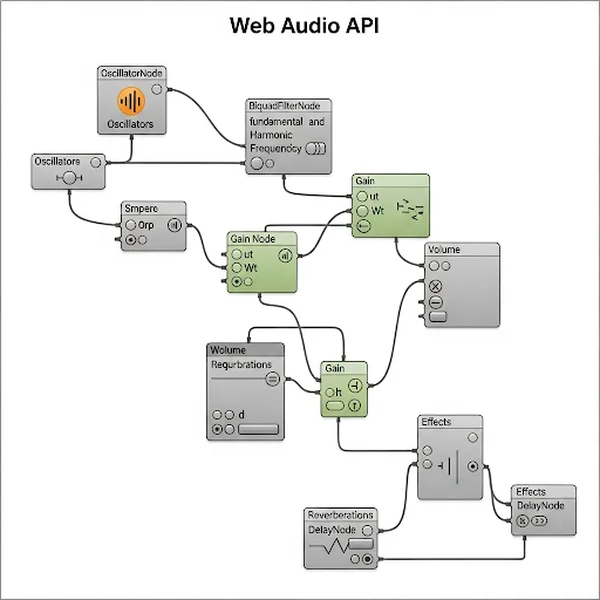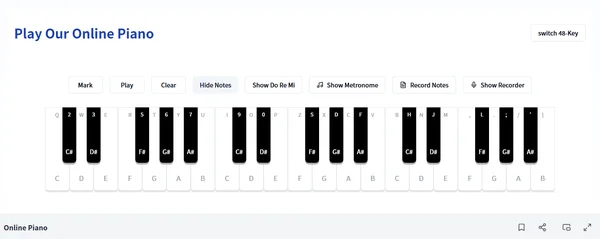Behind the Keys: The Technology Powering Our Online Piano
Unveiling the Tech Secrets of Virtual Piano
Have you ever wondered how an online piano can deliver a realistic playing experience right in your browser, completely free of charge? At Online Piano, we're passionate about democratizing music, making it accessible to everyone. This post dives into the technology that brings our online piano's features to life, from intricate audio processing to ensuring seamless browser compatibility. We believe anyone, regardless of their background, should have the opportunity to explore the joy of making music.
Audio Processing for Realistic Piano Sound

The heart of any virtual piano is its ability to reproduce the rich, nuanced sound of a real acoustic instrument. This involves several key audio processing techniques, carefully balanced to achieve an immersive experience.
-
From Samples to Synthesis: Creating Authentic Tones
We use a combination of meticulously recorded audio samples and advanced synthesis to generate realistic piano sounds. High-quality recordings of individual piano notes are stored and then manipulated algorithmically to create different pitches and dynamics. Advanced synthesis techniques are also employed to add richness and warmth, breathing life into the digital tones.
-
Real-time Audio Effects: Reverb, Chorus, and More
To further enhance the realism, we apply real-time audio effects such as reverb and chorus. These effects simulate the acoustic properties of a concert hall or studio, adding depth and dimension to the sound, making it sound as if you're playing in a grand performance space.
MIDI Technology: The Language of Digital Music

MIDI (Musical Instrument Digital Interface) is a crucial technology that allows our online piano's functionality to respond to your input with impressive accuracy.
-
How MIDI Input Translates to Piano Notes
When you press a key on your computer keyboard or click a key on the screen, a MIDI signal is instantly generated. This signal contains vital information about the note you played, its velocity (how hard you pressed the key), and its duration. Our online piano uses this information to trigger the appropriate audio sample or synthesize a note with the correct characteristics, creating a truly dynamic experience.
-
MIDI File Support: Playing and Recording Your Compositions
Our platform supports MIDI file playback, a handy tool for any budding musician. This allows you to load and play pre-composed music, dissecting the structure or simply enjoying the melody, as well as record your own performances for later listening or sharing.
Web Audio API: Bringing Sound to Your Browser

The Web Audio API is a powerful JavaScript interface that enables us to process and manipulate audio directly in your browser, without the need for external plugins.
-
Optimizing Audio Performance for Different Browsers
The Web Audio API provides fine-grained control over audio processing, allowing us to optimize performance for different browsers and devices, ensuring everyone has a smooth experience.
-
Handling Latency Issues: Ensuring a Responsive Experience
Latency (the delay between your input and the sound output) can be a major problem for online music applications, breaking the flow of creativity. We employ a number of techniques to minimize latency, including intelligent buffering and real-time processing algorithms.
Browser Compatibility: Ensuring a Seamless Experience Across Platforms
Making our online piano game accessible to everyone means ensuring it works seamlessly across a wide range of browsers and devices.
-
Testing and Optimization for Chrome, Firefox, Safari, and More
We regularly test our online piano on a diverse range of browsers to proactively identify and quickly fix any compatibility issues that may arise.
-
Dealing with Browser-Specific Audio Issues
Different browsers may have different implementations of the Web Audio API, which can sometimes lead to subtle inconsistencies in audio playback. We use browser-specific workarounds and fine-tune our code to address these issues and ensure a consistent and enjoyable experience for all users.
User Interface (UI) and User Experience (UX) Design

The technology behind our virtual piano is only part of the story. We also focus on creating an intuitive and enjoyable user experience for players of all skill levels.
-
Creating an Intuitive and Engaging Interface
Our goal is to create a user interface that is exceptionally easy to use and visually appealing. We provide clear instructions and helpful feedback to guide users through the playing experience, ensuring even first-time users feel comfortable.
-
Optimizing for Touchscreen and Keyboard Input
Whether you're using a desktop computer with a keyboard or a mobile device with a touchscreen, our online piano is meticulously designed to be responsive and enjoyable to play, adapting seamlessly to your preferred input method.
The Symphony of Technology and Music
The online piano keyboard experience you enjoy at Online Piano is a result of a harmonious blend of advanced audio processing, precise MIDI technology, the versatile Web Audio API, and, above all, careful attention to user experience. We are committed to pushing the boundaries of what's possible with online music technology and fulfilling our mission of making music creation accessible to absolutely everyone, completely free of charge.
Your Burning Questions Answered
-
What audio processing techniques are used to create the piano sound?
We use a sophisticated combination of audio samples, synthesis, and real-time audio effects to capture the essence of a real piano.
-
How does the online piano handle latency issues?
We employ a range of techniques including intelligent buffering and real-time processing to keep latency to an absolute minimum.
-
Which browsers are best supported for the online piano?
We strive to support all major browsers, including Chrome, Firefox, and Safari, ensuring a wide audience can enjoy our platform.
-
Can I use a MIDI keyboard with the online piano?
Currently, we primarily support keyboard and touchscreen input for ease of access, but MIDI keyboard support is something we may explore in the future based on user feedback.
-
Is the online piano compatible with mobile devices?
Yes, our virtual piano is meticulously designed to be fully compatible with mobile devices, allowing you to play on the go.
Call to Action: Start Playing Now!
Ready to experience the technology for yourself, completely free? Visit Online Piano today and unleash your inner musician! We'd love to hear your feedback and suggestions on how we can improve. Let us know what you think through our feedback form – your insights are crucial to making our online piano the best it can be!